
Prescribed burns can help peatlands when managed properly
Researchers at the University of Liverpool are reporting that prescribed burning, if managed properly, is not as harmful to peat growth as previously believed. In fact, prescribed burning can lead to multiple positive outcomes if the technique is sensibly rotated, according to the study.
Prescribed burning is a highly controversial technique where fires are set intentionally to manage the land. While the method is used around the world, it is met with criticism by conservationists who believe that prescribed burning stops peat growth, reduces carbon capture, and reduces the amount of peat-forming species such as Sphagnum mosses.
For their investigation into the effects of using this method, the scientists analyzed data from a long-term ecological experiment at Moor House National Nature Reserve. The reserve contained areas of moorland that either only been burned in 1954 or had been burned every ten or twenty years since 1954. These regions were compared with control areas that had not been burned since the 1920s.
The study was led by Emeritus Professor Rob Marrs from the University’s Department of Earth, Oceans & Ecological Sciences.
“The research, which was truly interdisciplinary and combined several scientific approaches, centred on a long-term, replicated experiment at Moor House National Nature Reserve,” said Professor Marrs. “As part of that experiment the moorland was subjected to four burning treatments to determine the change in composition of the main species. The value of long-term experiments is that they allow new hypotheses can be tested which were unforeseen at the start.”
The analysis of changes in vegetation composition showed that regions which had not been exposed to any prescribed burns were dominated by low-level peat-forming species with less useful species such as Sphagnum mosses and cotton grasses that promote peat growth.
Study co-author Professor Chiverrell led the team in collecting stratigraphical data on the rate of peat and carbon accumulation. The experts measured numerous peat profiles sampled from the different prescribed burn areas.
“This is first time that stratigraphical techniques have been used within the structure of a designed experiment,” said Professor Chiverrell. “Our data show only limited reduction of peat and carbon accumulation with increased burning treatments. Crucially, there was continued peat and carbon accumulation even in the areas that had undergone the regime of most frequent burning.”
When the researchers modeled how prescribed burning may influence the potential damage caused by severe wildfires, they found that the proper implementation of this technique can reduce fire fuel loads, protect against more severe ecosystem damage, allow better access for fighting wildfires, and promote faster recovery after a wildfire event.
“Our study produced surprising results that are the opposite of what many conservationists had previously thought,” said Professor Marrs. “It showed that the areas which had not been burnt since 1954 ended up with more heather and less peat forming species but the most frequently burned treatment had more of these species and did not stop carbon accumulation. We advise that prescribed burning be used in some areas within a moorland management plan to minimize fuel loads.”
“This work is unique because it uses stratigraphical methods, usually used to measure change over millennia, to assess recent environmental changes within a relatively long-term manipulative field experiment.”
The study is published in the journal Nature Geoscience.
—
By Chrissy Sexton, Earth.com Staff Writer













